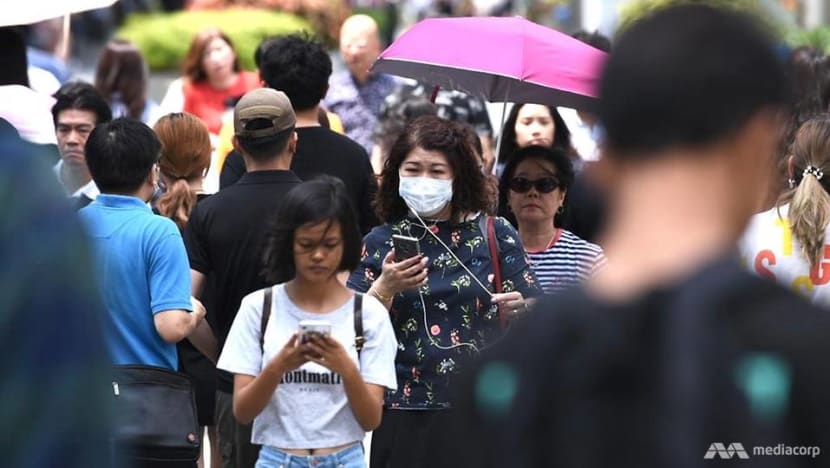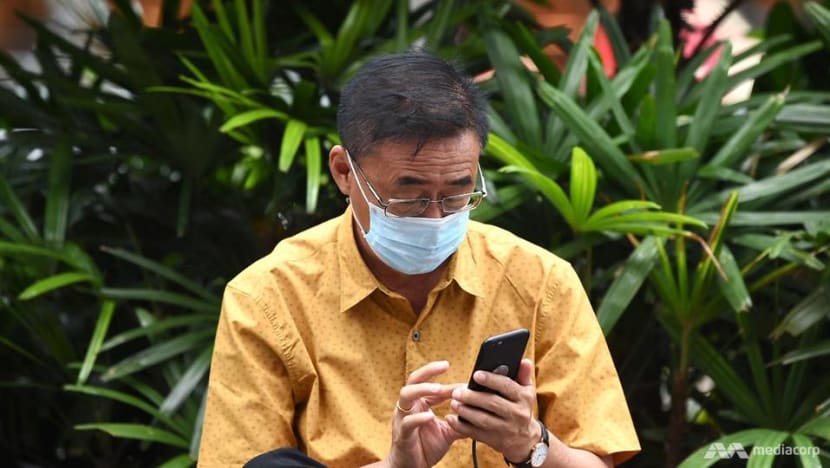commentary Commentary
Commentary: Wuhan virus - when social media and chat groups complicate crisis communication
Information on the Wuhan virus and what steps Singapore is taking have been timely. But authorities could do better to ensure communications are empathetic and responsive, says Professor Lim Sun Sun.

A woman is seen wearing a face mask at Orchard Road, Singapore on Jan 28, 2020. (Photo: Gaya Chandramohan)
SINGAPORE: In as much as the Wuhan virus is a challenge for our medical facilities, it is also proving to be a trying test of our communication infrastructure.
Specifically, are people being adequately and accurately informed about the virus, its spread and impact, and the measures we can take to protect ourselves while supporting its containment?
How can the different authorities manage their communication to ensure that this crisis propels everyone to act sensibly, while not triggering a state of panic?
COMMUNICATION HAS BEEN TRANSFORMED SINCE SARS
When SARS reared its head in 2003 and cast a gloomy pall over Singapore, the situation was significantly different but presented critical lessons for us as we now race to manage the fallout from the Wuhan virus.
Seventeen years ago, our media landscape was vastly more manageable than the cacophonous environment we inhabit today. Smartphones were yet to be invented, and social media was but a fledgling phenomenon.
The position of trusted and long-established news providers was still strong, albeit challenged by the rise of alternative online media outlets.
READ: Commentary: SARS was scary, but the experience was invaluable in shaping our Wuhan virus response
MORE: Our coverage on the Wuhan virus and its developments
The public relied principally on news purveyors that practised gatekeeping measures and were held to professional best practices of authentication and verification.
During SARS, public communication from the government and businesses was conveyed mainly through press releases and media coverage.
Most importantly, in 2003, the ordinary person did not wield the communicative power then as they do now.

Whereas we can share information through multiple social media and messaging platforms more easily and swiftly today, this rapid propagation of news and information was previously the exclusive preserve of media companies.
The democratisation of media production and dissemination we currently enjoy has heralded a lively but rambunctious world where official communication fights with user-generated tweets, memes and videos for eyeballs.
It is in precisely such a climate that misinformation and disinformation about an unfolding crisis thrive.
A PROLIFERATION OF MISINFORMATION AND FALSEHOODS
Already, we have seen a proliferation of rumours and online falsehoods misleading the public on the Wuhan virus, including accounts of miraculous recoveries and reports that someone in Singapore had already died from the disease.
Thankfully, the latter was swiftly dealt a blow from the office administering the Protection from Online Falsehoods and Manipulation Act (POFMA).
More egregiously, hate speech that demonises people from China or wild allegations about the disease emerging from a systematic bio-terrorism programme seem to be spreading more rapidly than the disease itself. Such falsehoods only serve to stoke racism and xenophobia, needlessly straining our social fabric.
READ: China vows to slay 'devil' virus, as countries scramble to evacuate citizens
READ: Commentary: Why the Wuhan virus situation could get worse soon
With their sensationalist and inflammatory nature that tap into people’s innate fear of the unknown, these falsehoods possess an alarming potency, coursing through social networks much like a contagion does.
In a fast-evolving crisis where we need voices of authority to provide clarity, navigating such a chaotic media milieu is tantamount to steering a dinghy through stormy waters.

SOME CALM TO A PRECARIOUS SITUATION
In Singapore, some positive steps have helped to lend calm to a precarious situation.
The convening of a high-level press conference involving ministers from a swathe of key ministries signalled the severity of the problem and the seriousness with which it is being tackled. That it was held on a public holiday further underlined the urgency of the situation.
These high-profile efforts were accompanied by the launch of a gov.sg WhatsApp subscription for people to request updates on the virus and a Ministry of Health website dedicated to providing the same.
Such initiatives are valuable because they target people on platforms they are comfortable with and active on, drawing them in as potential allies in the fight against falsehoods.
READ: Commentary: Does it really matter if WHO hasn't designated Wuhan virus a global public health emergency?
READ: Commentary: Wuhan virus sparks questions over local Chinese officials' disclosure of information
However, the low frequency of posts on the gov.sg WhatsApp account, and the clinical way with which the information is presented — as standard text messages - fails to give the accurate information they are sharing the traction that it needs.
In a media environment replete with attractively packaged falsehoods, official voices must work harder and smarter to seize the audience’s already limited attention.
If official advisories are not accompanied by eye-catching infographics and tip sheets, such critical information will not attain the virality it needs to ensure that people take sensible precautions.

Essential information must be packaged so that people will liberally share and disseminate them, as willingly as they do hoaxes and urban legends. For senior citizens who have a fondness for sharing videos via WhatsApp, short and snappy videos in multiple languages should be produced to explain the protective steps individuals can take.
Some may recall that considerable effort was poured into public communication after SARS was declared a national emergency, an experience which is highly instructive.
A SARS rap and SARS song were aired on television, while cartoons and accessible language were used in posters, pamphlets and newspaper infomercials, thus adding to their reach.
Above all, official communication must exude empathy. Sociologists have long identified and lauded human beings’ unique ability to see things from another person’s perspective.
When political leaders and government officials acknowledge people’s anxieties and apprehensions, while prescribing the appropriate course of action, their voices will ring louder and clearer.
For example, Prime Minister Lee Hsien Loong struck the right note in his latest Facebook post by recognising people’s concerns before he explained prudential measures and cautioned against succumbing to rumours and hearsay. In anxious climes, a compassionate voice is a much more persuasive one.
Mechanically dispensed advice is no match for falsehoods born out of clever social engineering that exploits people’s cognitive biases and human foibles.
Effective crisis communication must thus be empathetic, responsive and timely to quell worries and boost confidence. Furthermore, a proactive communication approach will help to avert speculation and fear-mongering.
In our prevailing reality, information is vulnerable to the dynamics of social media and communicators must both confront and ride this beast.
Unless there is strategy and sensitivity in crisis communication during such troubled times, our populace will fall prey to conjecture, confusion, and conspiracies.
Lim Sun Sun is professor of communication and technology and head of humanities, arts and social sciences at the Singapore University of Technology and Design. She is also a Nominated Member of Parliament. Her latest book is Transcendent Parenting: Raising Children in the Digital Age.
Subscribe to our Telegram channel for the latest updates on the Wuhan virus outbreak: https://cna.asia/telegram
Full coverage: https://cna.asia/wuhan-virus














